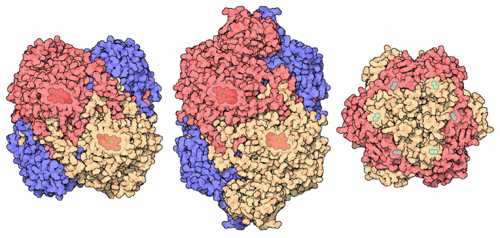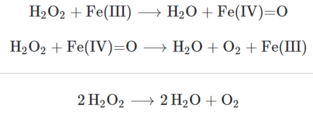Catalase
From Proteopedia

Contents |
Function
Catalase (CAT) catalyzes the conversion of hydrogen peroxide to water and oxygen. CAT contains porphyrin-heme Fe group which reacts with the hydrogen peroxide. CAT containing Mn are called pseudocatalase (PCAT).[1] Catalase-peroxidase (CAT KatG) is a bifunctional enzyme with both catalase and peroxidase activities. CAT KatG cofactor is a heme group. It provides defense against oxidative stress by reducing hydrogen peroxide. Mutations in CAT KatG can cause resistance to the anti-malarial drug isoniazid (INH).[2] Catalase-phenol oxidase (CATPO) is a heme-containing CAT which shows phenol oxidase activity.[3]
There are four oxygen atoms total in the reactants. Which do you think will be paired up after the reaction is completed (i.e. in the dixoxygen molecule O2 from as one of the products)?
Structure
| |||||||||||
pH dependence
The following video shows how the rate of the potato catalase depends on the pH. Do you have a hypothesis why both low and high pH slow down the enzyme compared to neutral pH? Which acid/base groups are part of the mechanism described above? How is the structure (shape) of the enzyme affected by changes in pH?
See also
Ann Taylor/Catalase
Human Erythrocyte Catalase
Catalase 2CAG bcce2014.
See also Catalase (Hebrew).
3D Structures of catalase
References
- ↑ Purwar N, McGarry JM, Kostera J, Pacheco AA, Schmidt M. Interaction of Nitric Oxide with Catalase: Structural and Kinetic Analysis. Biochemistry. 2011 May 6. PMID:21524057 doi:10.1021/bi200130r
- ↑ Bertrand T, Eady NA, Jones JN, Jesmin, Nagy JM, Jamart-Gregoire B, Raven EL, Brown KA. Crystal structure of Mycobacterium tuberculosis catalase-peroxidase. J Biol Chem. 2004 Sep 10;279(37):38991-9. Epub 2004 Jul 1. PMID:15231843 doi:10.1074/jbc.M402382200
- ↑ Koclar Avci G, Coruh N, Bolukbasi U, Ogel ZB. Oxidation of phenolic compounds by the bifunctional catalase-phenol oxidase (CATPO) from Scytalidium thermophilum. Appl Microbiol Biotechnol. 2013 Jan;97(2):661-72. doi: 10.1007/s00253-012-3950-2., Epub 2012 Feb 28. PMID:22370948 doi:http://dx.doi.org/10.1007/s00253-012-3950-2
- ↑ Melik-Adamyan W, Bravo J, Carpena X, Switala J, Mate MJ, Fita I, Loewen PC. Substrate flow in catalases deduced from the crystal structures of active site variants of HPII from Escherichia coli. Proteins. 2001 Aug 15;44(3):270-81. PMID:11455600
- ↑ Melik-Adamyan W, Bravo J, Carpena X, Switala J, Mate MJ, Fita I, Loewen PC. Substrate flow in catalases deduced from the crystal structures of active site variants of HPII from Escherichia coli. Proteins. 2001 Aug 15;44(3):270-81. PMID:11455600
Proteopedia Page Contributors and Editors (what is this?)
Michal Harel, Alexander Berchansky, Karsten Theis, Ann Taylor


